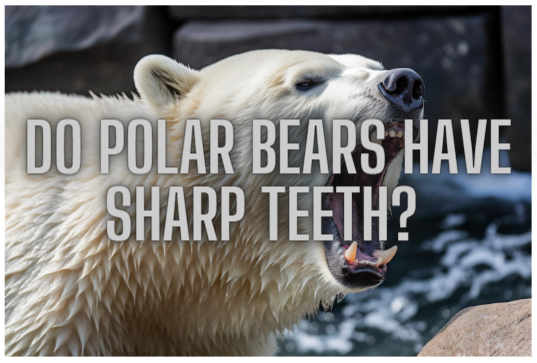Polar bears, the majestic giants of the Arctic, possess a set of formidable teeth that are finely adapted to their unique lifestyle. In this article, we delve into the fascinating world of polar bear dentition, examining the sharpness and functionality of their teeth and their crucial role in their survival.
Anatomy of Polar Bear Teeth
Polar bears, like other bears, are classified as carnivores. Their teeth reflect their dietary adaptations, combining elements for both hunting and consuming prey. At the front of their mouths, polar bears possess sharp incisors, which are used for grasping and holding onto prey. These incisors are followed by large and powerful canines, which are exceptionally sharp and serve as formidable weapons for capturing and killing seals, their primary prey in the wild. Behind the canines, polar bears have premolars and molars that aid in cutting and crushing bones and plant material.
Functionality and Adaptations
The sharp teeth of polar bears are crucial to their survival in the harsh Arctic environment. The long, sharp canines, in particular, are instrumental in securing their main food source—seals. Polar bears primarily hunt seals by ambushing them from breathing holes in the ice. With their powerful jaws and sharp canines, they can pierce through the seals’ thick blubber and deliver a lethal bite to the vital areas, effectively incapacitating their prey.
Furthermore, the teeth of polar bears have evolved to withstand the extreme conditions in which they live. Their enamel is exceptionally hard, enabling them to gnaw on frozen meat and bones without causing damage to their teeth. This adaptation is vital, as the Arctic climate often necessitates the consumption of frozen prey.
Polar Bear Teeth Sizes
Polar bears have large and powerful teeth, which are adapted to their carnivorous diet and hunting habits. Here are the average size ranges for the different types of teeth in adult polar bears:
Incisors: The incisors are the front teeth used for grasping and holding prey. The upper incisors are typically around 3 to 4 centimeters (1.2 to 1.6 inches) long, while the lower incisors are slightly smaller, ranging from 2 to 3 centimeters (0.8 to 1.2 inches) in length.
Canines: The canines, also known as the fangs, are the long and sharp teeth used for capturing and killing prey. Polar bear canines are impressive in size, with the upper canines measuring around 5 to 6 centimeters (2 to 2.4 inches) in length. The lower canines are slightly smaller, ranging from 4 to 5 centimeters (1.6 to 2 inches) long.
Premolars and Molars: The premolars and molars are located in the back of the polar bear’s mouth and are used for cutting, tearing, and crushing food, including meat and bones. While specific measurements for these teeth can vary, the premolars and molars are generally larger than the incisors and canines.
Can Polar Bears Lose Their Teeth?
Polar bears typically begin to develop their baby teeth at around three to four weeks of age. These baby teeth, also called milk teeth or primary teeth, start to emerge when the cubs are about three to four months old. The baby teeth serve the cubs well during their early stages of life, allowing them to eat solid food as they transition from their mother’s milk to a more varied diet.
As the polar bear cubs grow, their permanent teeth develop beneath the baby teeth. The process of tooth exfoliation, where the roots of the baby teeth are reabsorbed, causes the baby teeth to become loose and eventually fall out. This usually occurs between the ages of two and three years, but it can vary for individual bears.
The permanent teeth that replace the baby teeth are larger and more robust, reflecting the bear’s transition to an adult diet and lifestyle. Once the permanent teeth have fully erupted, the polar bear’s dental structure is complete. The adult teeth will be with the polar bear for the rest of its life, provided they maintain good oral health.
It’s worth noting that like humans, polar bears can also experience dental issues such as tooth decay, periodontal disease, and tooth loss due to various factors, including poor oral hygiene or injuries. However, the natural process of losing and replacing teeth in polar bears occurs during their early development as they transition from baby teeth to adult teeth.
Final Thoughts
Polar bears possess a set of sharp teeth that are perfectly suited to their carnivorous lifestyle in the Arctic. Their incisors, canines, premolars, and molars work in harmony to facilitate hunting, capturing, and consuming prey. The sharp canines, in particular, play a pivotal role in the polar bear’s ability to secure its primary food source—seals. Through their dental adaptations, polar bears showcase the incredible ways in which animals have evolved to thrive in their specific habitats. Understanding the teeth of polar bears provides us with a deeper appreciation for these magnificent creatures and their remarkable adaptations to their icy world.

